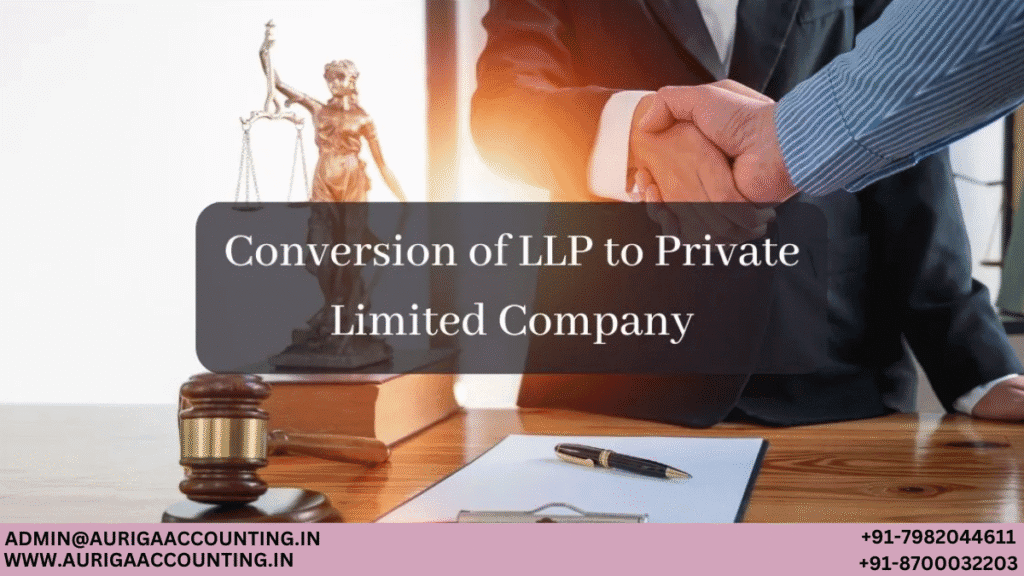Rohit is an experienced legal writer who excels at translating complex legal concepts into clear, actionable advice. His writing equips entrepreneurs with the legal knowledge they need to confidently start, manage, and scale their businesses.

Conversion : LLP to Private Limited Company
Introduction
ToggleMany businesses in India that initially began as Limited Liability Partnerships (LLPs) are increasingly choosing to convert into Private Limited Companies to unlock greater growth potential, attract equity investment, and enhance their market reputation. This conversion is governed by Section 366 of the Companies Act, 2013, along with the Companies (Authorised to Register) Rules, 2014.
To be eligible, the LLP must meet certain requirements, including a minimum of seven partners, unanimous consent from all partners, publication of public notices in both local and national newspapers, and securing a No Objection Certificate (NOC) from the Registrar of Companies (RoC).
While the process may appear complex, IndiaFilings streamlines every step of the transition, ensuring a smooth and compliant conversion—allowing you to focus on scaling your business with confidence.
What is an LLP?
A Limited Liability Partnership (LLP) is a hybrid business structure introduced in India in 2008, combining the benefits of traditional partnerships and private companies. LLPs enjoy features such as:
Limited liability protection for partners
Separate legal identity
Perpetual succession
Lower compliance requirements
Despite these advantages, LLPs face limitations that often prompt businesses to convert to a Private Limited Company, particularly for scaling operations and attracting investment.
Challenges of LLPs
Higher Tax Rate: LLPs are taxed at a flat rate of 30%, unlike Private Limited Companies which benefit from a reduced corporate tax rate of 22%–25%.
Limited Fundraising Capabilities: LLPs cannot issue shares, restricting access to equity funding from investors or venture capitalists.
Recognizing these drawbacks, many businesses choose to convert their LLP into a Private Limited Company to access broader growth and investment opportunities, while retaining existing goodwill and operational continuity.
Legal Framework for LLP to Private Limited Company Conversion
The process is governed by:
Section 366 of the Companies Act, 2013
The Companies (Authorised to Register) Rules, 2014
To ensure a valid conversion, the LLP must fulfill prescribed eligibility criteria and follow a defined legal process.
Benefits of Converting LLP to Private Limited Company
Greater Growth Opportunities
A company structure better supports expansion and large-scale operations.Enhanced Capital Raising Options
Ability to raise funds via equity shares and debentures; issue ESOPs.Favorable Taxation
Access to a lower corporate tax rate (22%–25%) and tax exemptions on conversion.Public Listing Potential
Scope to convert into a public limited company in the future.Preservation of Brand Value
Retains existing business name and goodwill post-conversion.Increased Foreign Investment Appeal
Fewer compliance hurdles for attracting FDI.
Eligibility Criteria for Conversion
To convert an LLP into a Private Limited Company, the following conditions must be met:
Minimum Partners:
At least two partners in the LLP. After conversion:Minimum two shareholders
Minimum two directors (one resident in India)
Unanimous Consent:
All LLP partners must approve the conversion.No Unresolved Liabilities:
If liabilities exist, written NOC from all creditors is mandatory.Up-to-date Financial Compliance:
Latest audited financial statements required, prepared no more than six days prior to RoC submission.Approved Company Name:
Name must be reserved and approved by the RoC as per Companies Act norms
Key Legal Provisions for Conversion
1. Transfer of Property (Section 368)
All assets, liabilities, and rights of the LLP vest in the Private Limited Company upon registration.
2. Retention of Liabilities (Section 369)
The converted company remains accountable for all pre-conversion obligations.
3. Legal Continuity (Section 370)
Ongoing legal proceedings involving the LLP can continue unaffected post-conversion.
4. Name Reservation
Submit an e-Form for name approval, ensuring compliance with naming guidelines.
Pre-Conversion Obligations
Consent from Secured Creditors
NOCs or written consent from all secured creditors are mandatory.
Public Notification
Publish a notice of intent in Form URC-2
In one local (vernacular) and one English newspaper
Invite public objections within 21 days
Submission of Notices
Attach copies of published notices and LLP Registrar service proofs to Form URC-1.
Documentation Required for Conversion
For Company Limited by Shares
List of Partners & Share Details
Names, addresses, shareholding (cash/non-cash), and consideration source
Must be updated within six days of filing
List of First Directors
Names, DINs, passport details (if applicable), addresses, and declarations
NOC from Creditors and Latest ITR
Consent from charge holders
Copy of the latest income tax return
For Company Limited by Guarantee
List of Members & Directors
Names, addresses, DINs, and declarations
Proof of membership and director consent
Resolution for Guarantee Amount
Additional Compliance Documents
NOC from creditors
Latest ITR copy
Verification and Filing Requirements
All lists and declarations must be verified and signed by at least two proposed directors
Ensure Form URC-1 includes all mandatory annexures based on the new company type.
Additional Obligations Under Section 374
Statement of Accounts
Prepared no more than 15 days before application
Must be audited and certified
Compliance Declaration
Confirm all required filings under the LLP Act have been completed
Statement of Legal Proceedings
Disclose all pending litigation or regulatory matters.
Step-by-Step Process for Converting an LLP into a Private Limited Company
The conversion of a Limited Liability Partnership (LLP) into a Private Limited Company is governed by Section 366 of the Companies Act, 2013, and the Companies (Authorised to Register) Rules, 2014. Below is a detailed step-by-step guide to help you navigate the process efficiently:
1. Name Reservation
Submit the RUN (Reserve Unique Name) form on the MCA portal to apply for the proposed name of the Private Limited Company.
Ensure the name complies with the naming guidelines outlined in the Companies Act, 2013.
Once approved, the reserved name is valid for 60 days.
2. Obtain Digital Signature Certificate (DSC) and Director Identification Number (DIN)
Acquire DSC for all proposed directors of the new company.
Apply for DIN through Form DIR-3 (if the directors do not already have one).
3. Publish Public Notice
Publish a notice of intention to convert the LLP into a Private Limited Company using Form URC-2.
The notice must be published in:
One vernacular newspaper (local language), and
One English newspaper circulating in the district where the LLP is registered.
Allow 21 clear days for the public to raise any objections.
4. File Form URC-1 with Required Documents
Submit Form URC-1 to the Registrar of Companies (RoC) along with all mandatory supporting documents, including:
List of partners/members
Details of directors
NOC from creditors
Latest financial statements
Income tax return
Proof of newspaper publication
5. Draft and Submit MoA and AoA
Prepare the Memorandum of Association (MoA) and Articles of Association (AoA) of the proposed company.
These documents define the company’s objectives and governance structure.
Submit them to the RoC, ensuring alignment with the approved name and company structure.
6. Address Public or Regulatory Objections
The RoC will assess the application and any objections received during the notice period.
Provide necessary clarifications or documentation to resolve any raised objections or concerns.
7. Issuance of Certificate of Incorporation
Upon satisfaction of all compliance requirements and payment of applicable fees, the RoC will issue a Certificate of Incorporation (Form INC-11).
The LLP is thereby dissolved under the Limited Liability Partnership Act, 2008, and the business officially operates as a Private Limited Compan.
Dissolution of LLP Upon Conversion to a Private Limited Company
In accordance with Section 374 of the Companies Act, 2013, and Rule 4 of the Companies (Authorised to Register) Rules, 2014, once an LLP is successfully registered as a Private Limited Company, it is automatically deemed dissolved under the provisions of the Limited Liability Partnership Act, 2008.
No separate action or formal procedure is required to effectuate this dissolution—the conversion itself serves as the final step in terminating the LLP’s legal existence.
About the Author
Rohit
September 16, 2025
new
June 10, 2025
February 8, 2024
February 7, 2024
February 1, 2024
January 25, 2024
January 24, 2024
January 24, 2024
January 23, 2024
January 19, 2024
January 17, 2024
January 13, 2024
January 10, 2024
January 4, 2024
December 30, 2023
December 30, 2023
August 19, 2023
August 18, 2023
August 12, 2023
August 12, 2023
August 12, 2023
August 12, 2023
August 12, 2023
August 12, 2023
August 12, 2023
August 11, 2023
August 11, 2023
August 11, 2023
August 11, 2023
August 11, 2023
August 11, 2023
August 11, 2023
August 11, 2023
August 10, 2023
August 10, 2023
August 10, 2023
August 10, 2023
August 7, 2023
August 7, 2023
August 7, 2023
August 4, 2023
August 4, 2023
August 4, 2023
August 3, 2023
August 3, 2023
August 2, 2023
August 2, 2023
August 2, 2023
July 22, 2023
July 22, 2023
July 19, 2023
July 19, 2023
July 17, 2023
July 17, 2023
July 17, 2023
July 14, 2023
July 13, 2023
July 13, 2023
July 13, 2023
June 24, 2023
June 22, 2023
RELATED ARTICLES
OPC to Private...
Dematerialization...
WHO IS ELIGIBLE...
HOW DO I REGISTER...
CAN I REGISTER...
No posts found












